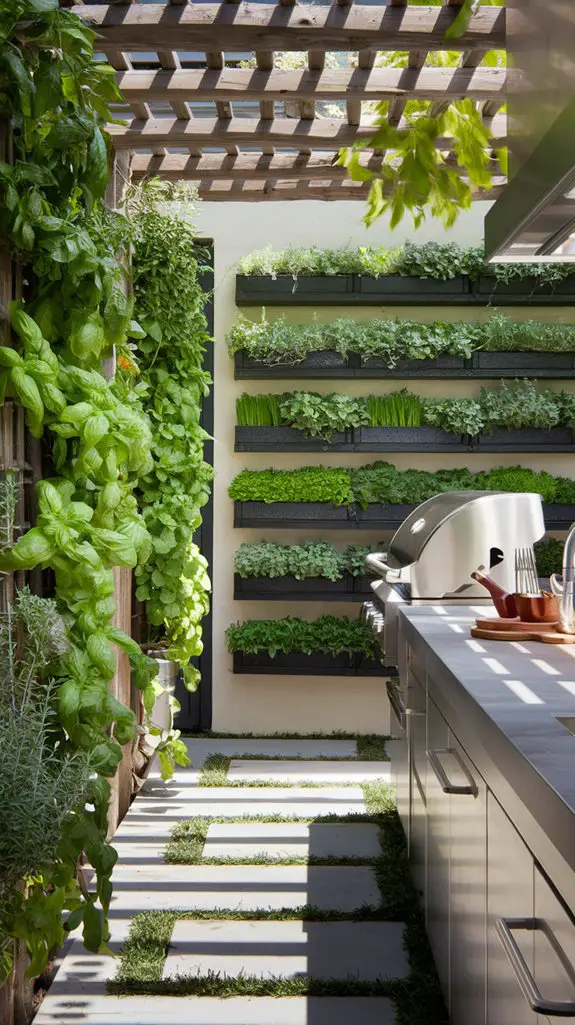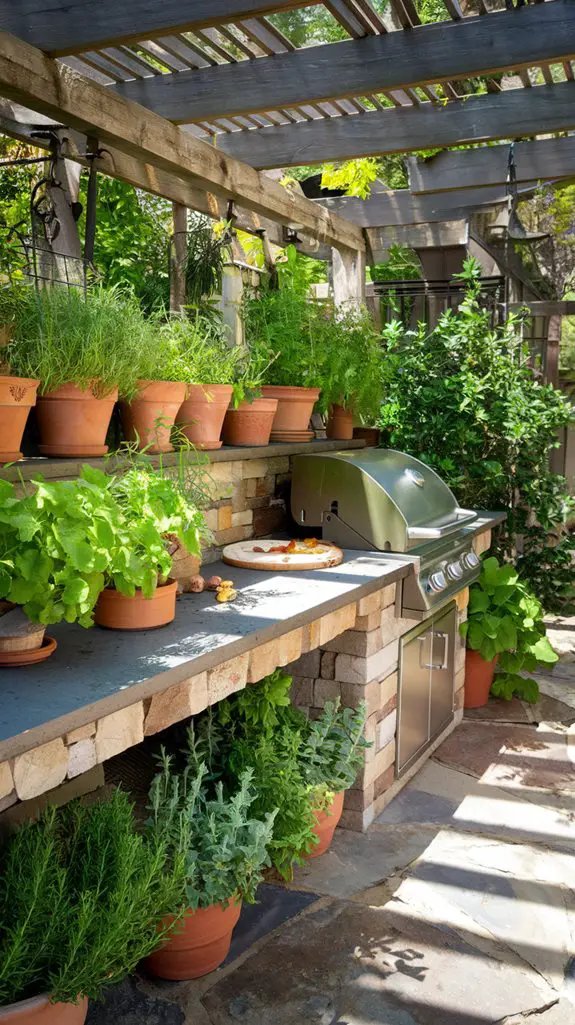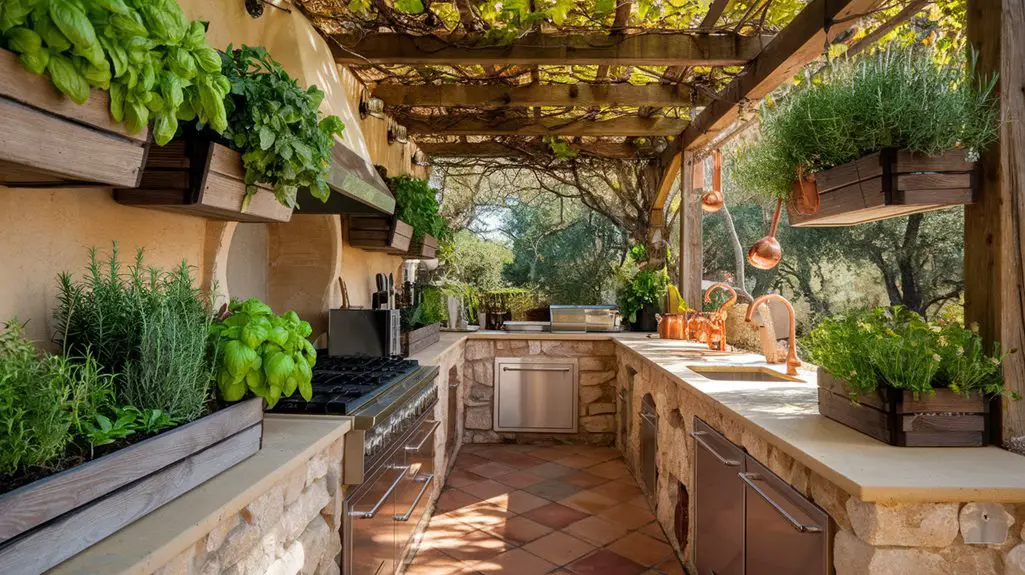Imagine stepping into your outdoor kitchen, the sun warming your skin, while the fragrant aroma of fresh herbs fills the air. Crafting a space that seamlessly blends culinary creativity with nature can elevate your cooking experience. But where do you start? From selecting the perfect location to ensuring easy access to your herbs, there are essential tips that can transform your outdoor kitchen into a vibrant culinary haven. Let's explore how to achieve this harmonious balance.
Choose the Right Location for Your Herb Garden
When you're planning your outdoor kitchen, the location of your herb garden can make all the difference.
Position it close to your cooking area for easy access, ensuring you can snip fresh basil or thyme as you prepare meals.
Consider sunlight—most herbs crave six to eight hours of direct light daily, so choose a spot that bathes in sunshine.
Avoid areas with heavy foot traffic; you don't want your herbs trampled or overshadowed by larger plants.
Incorporating raised beds or pots can elevate your herbs, providing better drainage and visibility.
Finally, think about proximity to water sources for easy irrigation.
A well-placed herb garden not only enhances your culinary experience but also adds beauty to your outdoor kitchen. Additionally, consider creating herb garden themes that reflect the cuisines you enjoy most, making your garden not only functional but also a source of inspiration while cooking.
Select Herbs That Thrive in Your Climate
With your herb garden's location established, the next step is selecting the right herbs that will flourish in your specific climate.
Start by researching your hardiness zone, as it dictates which herbs can thrive. In warmer climates, basil, rosemary, and oregano love the heat, while cooler regions favor chives, parsley, and mint.
Consider your garden's sun exposure too; sun-loving herbs like thyme and sage need at least six hours of sunlight daily. If you live in a humid area, opt for herbs like cilantro and dill, which appreciate moisture.
Remember to plant perennials like chives and tarragon for a lasting yield. Additionally, incorporating beneficial insects can help pollinate your herbs and keep pests at bay. By choosing herbs suited to your environment, you'll guarantee a vibrant and productive garden.
Incorporate Vertical Gardening Solutions

While maximizing space in your outdoor kitchen and herb garden, incorporating vertical gardening solutions can elevate both aesthetics and functionality.
Consider using wall-mounted planters or trellises to create a stunning display of herbs like basil, thyme, and rosemary. Not only will this save space, but it'll also keep your herbs accessible while adding visual interest.
You can also install vertical garden systems or hanging pots, which create a lush backdrop for your cooking area. Incorporating a vertical herb garden encourages airflow and sunlight exposure, promoting healthy growth. Additionally, eco-friendly vertical gardening methods can enhance sustainability in your outdoor space.
Plus, it's a great way to showcase your creativity and personal style. So, get inventive with your vertical gardening solutions, and watch your outdoor kitchen thrive!
Use Planters That Complement Your Outdoor Kitchen Design
Choosing the right planters for your outdoor kitchen not only enhances the overall aesthetic but also ties together your herb garden with your cooking space.
Consider materials that reflect your kitchen's style—ceramic pots can add a touch of elegance, while rustic wooden planters offer a charming, farmhouse feel.
Opt for colors that harmonize with your outdoor design; earthy tones can blend seamlessly, while bright hues can create a lively contrast.
Don't forget about size and shape; sleek, tall planters can save space, while wider, low-profile options work great on countertops.
Incorporating planters that match your kitchen's theme creates a cohesive look, making your herb garden a delightful extension of your culinary haven. Additionally, using sustainable materials for your planters can further enhance the eco-friendliness of your outdoor space.
Let your creativity shine!
Ensure Easy Access to Herbs While Cooking

To whip up a delicious meal, you need quick access to your favorite herbs, so it's important to think about their placement in your outdoor kitchen. Position your herb garden close to your cooking area, like near the grill or prep station. Consider using vertical planters or wall-mounted shelves to save space and keep herbs at arm's length. Additionally, integrating fragrant herb gardens can enhance your cooking experience by providing a sensory appeal.
| Herb | Ideal Placement | Usage Tips |
|---|---|---|
| Basil | Near the grill | Perfect for sauces |
| Rosemary | On the countertop | Great for marinades |
| Thyme | Hanging planter | Use in roasted dishes |
| Cilantro | Wall planter | Essential for salsa |
| Parsley | Close to prep | Sprinkle on salads |
With thoughtful placement, you'll elevate your cooking experience!
Create a Watering and Maintenance Plan
Having easy access to your herbs is only part of the equation; keeping them healthy and thriving is just as important.
Start by establishing a consistent watering schedule—herbs generally prefer moist soil, but be careful not to overwater. Check the top inch of soil; if it's dry, it's time to water. Consider using a drip irrigation system for efficiency.
Next, dedicate time weekly to inspect your plants for pests or signs of disease. Prune regularly to encourage growth and prevent overcrowding.
Fertilize every few weeks with a balanced organic fertilizer to boost nutrient levels. Finally, keep a gardening journal to track your maintenance activities and observe which herbs flourish best in your outdoor kitchen setting. Additionally, consider companion planting with herbs to promote biodiversity and enhance the growth of your garden.
This plan guarantees your herbs stay vibrant and flavorful.
Experiment With Companion Planting for Flavor Enhancement
While you're cultivating your herb garden, consider the benefits of companion planting to enhance the flavors of your culinary creations. Pairing herbs like basil with tomatoes not only boosts their growth but also intensifies their taste in dishes.
Think about adding rosemary near beans; the savory scent can deter pests while enriching your meals. Mint's invigorating notes thrive alongside cabbage, enhancing its flavor profile.
Experiment with chives and carrots, where the chives' onion-like taste elevates the earthy sweetness of carrots. By mixing these plants, you'll create a vibrant ecosystem in your garden that supports both growth and flavor. Additionally, companion planting techniques can help you discover even more beneficial pairings that elevate your herb garden.
Don't shy away from trying different combinations—your taste buds will thank you with every delightful dish you prepare!
Conclusion
As you cultivate your outdoor kitchen and herb garden, think of it as a symphony where every herb plays its unique note, enhancing the melody of your culinary creations. By choosing the right location, selecting thriving herbs, and integrating thoughtful design, you're not just growing plants; you're crafting a vibrant oasis. Let your garden be the brushstroke that paints flavor and beauty into your meals, transforming every dish into a masterpiece that reflects your passion for cooking.




